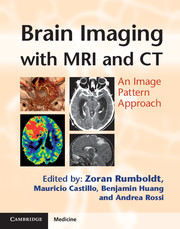Book contents
- Frontmatter
- Contents
- List of contributors
- List of abbreviations
- Preface
- Section 1 Bilateral Predominantly Symmetric Abnormalities
- Section 2 Sellar, Perisellar and Midline Lesions
- Section 3 Parenchymal Defects or Abnormal Volume
- Section 4 Abnormalities Without Significant Mass Effect
- 97 Dural Venous Sinus Thrombosis
- 98 Dural Arteriovenous Fistula
- 99 Subarachnoid Hemorrhage
- 100 Laminar Necrosis
- 101 Neurocutaneous Melanosis
- 102 Superficial Siderosis
- 103 Polymicrogyria
- 104 Seizure-Related Changes (Peri-Ictal MRI Abnormalities)
- 105 Embolic Infarcts
- 106 Focal Cortical Dysplasia
- 107 Tuberous Sclerosis Complex
- 108 Dysembroplastic Neuroepithelial Tumor (DNT, DNET)
- 109 Nonketotic Hyperglycemia With Hemichorea–Hemiballismus
- 110 Hyperdensity Following Endovascular Intervention
- 111 Early (Hyperacute) Infarct
- 112 Acute Disseminated Encephalomyelitis (ADEM)
- 113 Susac Syndrome
- 114 Diffuse Axonal Injury
- 115 Multiple Sclerosis
- 116 Progressive Multifocal Leukoencephalopathy (PML)
- 117 Nodular Heterotopia
- 118 Neurosarcoidosis
- 119 Meningeal Carcinomatosis
- 120 Meningitis (Infectious)
- 121 Perineural Tumor Spread
- 122 Moyamoya
- 123 Central Nervous System Vasculitis
- 124 Subacute Infarct
- 125 Active Multiple Sclerosis
- 126 Capillary Telangiectasia
- 127 Developmental Venous Anomaly
- 128 Immune Reconstitution Inflammatory Syndrome (IRIS)
- 129 Ventriculitis
- Section 5 Primarily Extra-Axial Focal Space-Occupying Lesions
- Section 6 Primarily Intra-Axial Masses
- Section 7 Intracranial Calcifications
- Index
- References
126 - Capillary Telangiectasia
from Section 4 - Abnormalities Without Significant Mass Effect
Published online by Cambridge University Press: 05 August 2013
- Frontmatter
- Contents
- List of contributors
- List of abbreviations
- Preface
- Section 1 Bilateral Predominantly Symmetric Abnormalities
- Section 2 Sellar, Perisellar and Midline Lesions
- Section 3 Parenchymal Defects or Abnormal Volume
- Section 4 Abnormalities Without Significant Mass Effect
- 97 Dural Venous Sinus Thrombosis
- 98 Dural Arteriovenous Fistula
- 99 Subarachnoid Hemorrhage
- 100 Laminar Necrosis
- 101 Neurocutaneous Melanosis
- 102 Superficial Siderosis
- 103 Polymicrogyria
- 104 Seizure-Related Changes (Peri-Ictal MRI Abnormalities)
- 105 Embolic Infarcts
- 106 Focal Cortical Dysplasia
- 107 Tuberous Sclerosis Complex
- 108 Dysembroplastic Neuroepithelial Tumor (DNT, DNET)
- 109 Nonketotic Hyperglycemia With Hemichorea–Hemiballismus
- 110 Hyperdensity Following Endovascular Intervention
- 111 Early (Hyperacute) Infarct
- 112 Acute Disseminated Encephalomyelitis (ADEM)
- 113 Susac Syndrome
- 114 Diffuse Axonal Injury
- 115 Multiple Sclerosis
- 116 Progressive Multifocal Leukoencephalopathy (PML)
- 117 Nodular Heterotopia
- 118 Neurosarcoidosis
- 119 Meningeal Carcinomatosis
- 120 Meningitis (Infectious)
- 121 Perineural Tumor Spread
- 122 Moyamoya
- 123 Central Nervous System Vasculitis
- 124 Subacute Infarct
- 125 Active Multiple Sclerosis
- 126 Capillary Telangiectasia
- 127 Developmental Venous Anomaly
- 128 Immune Reconstitution Inflammatory Syndrome (IRIS)
- 129 Ventriculitis
- Section 5 Primarily Extra-Axial Focal Space-Occupying Lesions
- Section 6 Primarily Intra-Axial Masses
- Section 7 Intracranial Calcifications
- Index
- References
Summary
Specific Imaging Findings
The characteristic MR imaging appearance of capillary telangiectasia is a small area with ill-defined margins of faint “brush-like”, stippled, or “lacy” contrast enhancement, and without any mass effect, perifocal edema, or gliosis. In over half of the cases it is invisible on T2WI and FLAIR images, and in the remaining cases it shows mild T2 hyperintensity. The typical additional diagnostic clue, which is not always present, is a mild hypointensity on T2*-weighted images (GRE, SWI, EPI, PWI, BOLD), without clear “blooming” artifact. CT is almost always negative, while in rare cases it shows small calcifications. Angiography usually fails to reveal any abnormality. The most common location is in the pons, but it can be found anywhere in the brain and more rarely in the spinal cord. Capillary telangiectasia varies in size between a few millimeters and 2 cm; it may be associated with an adjacent developmental venous anomaly (DVA) and/or cavernoma (cavernous malformation).
Pertinent Clinical Information
Capillary telangiectasia is almost invariably an incidental, asymptomatic finding with very slow or absent growth. There are rare reports of symptomatic telangiectasias, which are usually larger than 1 cm in size. Clinical response and relapse on steroid treatment have been described. Hemorrhage is exceptional, and is thought to arise from commonly associated cavernous malformations. Capillary telangiectasia may also possibly be a radiation-induced vascular malformation. Due to its benign course, treatment and follow-up are not warranted. Misdiagnosis with metastatic neoplasms is common and should be avoided.
Information
- Type
- Chapter
- Information
- Brain Imaging with MRI and CTAn Image Pattern Approach, pp. 259 - 260Publisher: Cambridge University PressPrint publication year: 2012
